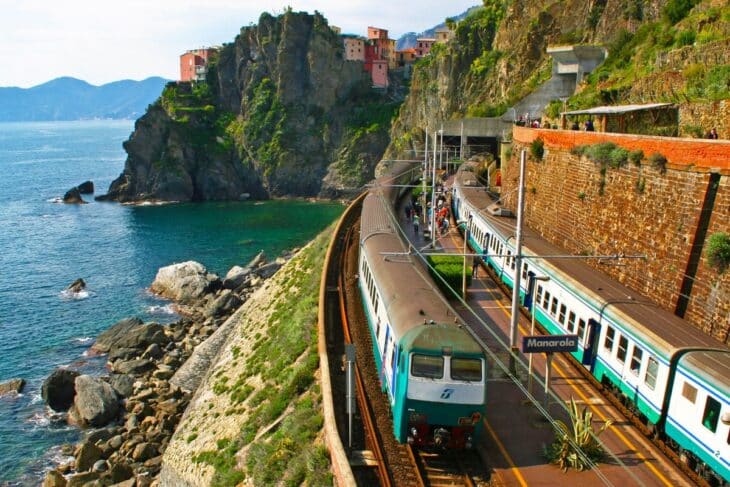Italy, known for its rich history, breathtaking landscapes, and vibrant culture, is a destination that captivates travellers from all over the world. When it comes to exploring Italy, one of the most convenient and efficient modes of transportation is the train. Italy’s extensive train network offers an exceptional way to experience the country’s diverse regions, picturesque cities, and charming towns. In this article, we will delve into the wonders of Italy by train, highlighting the key destinations, practical tips, and the overall allure of travelling through this beautiful country.
Italy’s Extensive Train Network
Italy boasts a well-developed train network, which is renowned for its efficiency, comfort, and widespread coverage. The Italian rail system is operated by Trenitalia, the national railway company, along with regional train services, such as Italo and local commuter trains. From the bustling metropolises like Rome, Milan, and Florence to the serene coastal towns of Cinque Terre and the enchanting cities of Venice and Naples, Italy’s train network seamlessly connects various destinations, making it an ideal choice for travellers.
Advantages of Traveling by Train in Italy
a) Accessibility: Italy’s train network provides excellent accessibility, connecting major cities, small towns, and even remote villages. This accessibility ensures that travellers can reach popular tourist destinations, as well as off-the-beaten-path gems, without the need for a car.
b) Scenic Journeys: Italy’s diverse landscapes offer spectacular train journeys. From the rolling hills of Tuscany to the dramatic Amalfi Coast, travelling by train allows passengers to witness the country’s natural beauty firsthand. The panoramic views from the train windows create an immersive and memorable experience.
c) Efficient and Reliable: Trains in Italy are known for their punctuality and reliability. The frequent departures and well-maintained schedules make it convenient for travellers to plan their itineraries and explore multiple cities within a short span of time.
d) Time and Cost-Effective: Train travel in Italy is often quicker and more cost-effective than other modes of transportation, especially when compared to flights. Trains typically depart from city centers, eliminating the need for additional transfers or lengthy airport commutes.

Key Destinations to Explore by Train
a) Rome: The capital city of Italy is a must-visit destination, and it serves as an excellent starting point for exploring the country. From the iconic Colosseum and Roman Forum to the Vatican City, Rome is a treasure trove of history and culture.
b) Florence: Renowned for its Renaissance art and architecture, Florence captivates visitors with its world-class museums, including the Uffizi Gallery and the Accademia Gallery. The picturesque cityscape and the stunning Duomo are sure to leave a lasting impression.
c) Venice: Built on water, Venice is a unique and romantic city that must be experienced. Travelling through its intricate canal network by Vaporetto or gondola is an enchanting way to discover the city’s hidden treasures, such as St. Mark’s Square and the Doge’s Palace.
d) Cinque Terre: Nestled along the Ligurian Coast, the five villages of Cinque Terre offer breathtaking coastal views, colourful houses, and scenic hiking trails. The train conveniently connects these picturesque villages, allowing visitors to hop between them and soak in their charm.
e) Amalfi Coast: Located in southern Italy, the Amalfi Coast is renowned for its stunning cliffside towns, such as Positano and Amalfi. Travelling by train to nearby cities like Naples and Sorrento provides easy access to this coastal paradise.

Practical Tips for Train Travel in Italy
a) Ticket Reservations: It is advisable to book train tickets in advance, especially during peak travel seasons, to secure the best fares and ensure availability. Tickets can be purchased online or at train stations.
b) Train Classes: Italy offers various train classes, including Frecciarossa, Frecciargento, and Regionale. Frecciarossa and Frecciargento are high-speed trains, while Regionale connects smaller towns. Each class offers different levels of comfort and amenities.
c) Validate Your Ticket: Before boarding a train in Italy, make sure to validate your ticket at the yellow validation machines located on the platforms. Failure to do so may result in a fine.
d) Baggage Storage: Trains in Italy provide designated spaces for luggage, including overhead racks and storage areas near the train doors. It is advisable to keep your belongings close and avoid leaving them unattended.
e) Dining Options: Many long-distance trains in Italy offer dining cars or trolley services where passengers can enjoy snacks, drinks, or even a full meal. However, it is also a good idea to bring some snacks and water for the journey.
Italy’s train network presents an incredible opportunity to explore the country’s diverse landscapes, cultural treasures, and hidden gems. Traveling by train in Italy not only offers convenience and efficiency but also allows travelers to immerse themselves in the stunning scenery along the way. From the historical streets of Rome to the romantic canals of Venice, the train journeys through Italy are an experience to cherish. So, hop on board, sit back, and let the rhythmic chug of the train transport you on an unforgettable adventure through this captivating country.
How to travel Italy by train: We promise it’s easy
Italian Trains: What You Need To Know
